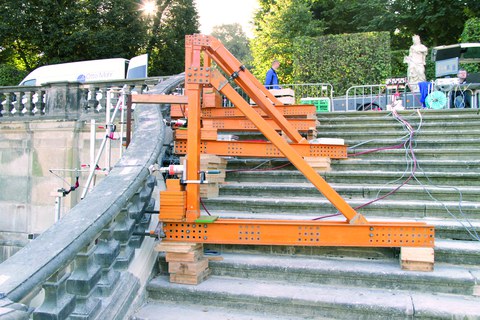Balustrades „Silent Music“
Table of contents
Project data
| Titel | Title Belastungsversuch zur experimentellen Bestimmung der Standsicherheit der Balustraden an der Stillen Musik im Barockgarten Großsedlitz | Load test to determine experimentally the stability of the balustrades on the Silent Music in the baroque garden Großsedlitz Auftraggeber | Client Staatsbetrieb Sächsisches Immobilien- und Baumanagement, NL Dresden I, Gruppe PBI Zeitraum | Period 09.2016 Leiter | Project leader Prof. Dr.-Ing. Dr.-Ing. E. h. Manfred Curbach Bearbeiter | Contributors Dipl.-Ing. (FH) Sabine Wellner, Tino Jänke, Michael Liebe, Maik Patricny, Andreas Thieme, Heiko Wachtel, Bernd Wehner |
Report in the yearbook 2016
The balustrades of the ‚Silent Music’

Test set-up at the western stair
The ‘silent music’ is a large and impressive sandstone stairway in the baroque garden Großsedlitz near Heidenau. After successful restoration, it should be released for public use again. A problem was that a computational proof of the standard loads could not be provided. Therefore, the stability of the balustrades of the western stair against an horizontal loading was experimentally tested with the help of a special loading experiment. In such loading experiments, it is difficult to realize a horizontal line load. Therefore, structural members to be tested are usually loaded with equivalent single loads.
For the test at Großsedlitz, four massive steel loading frames were constructed. On the one hand, a high dead load acts as counter bearing; on the other hand, it should be prevented that the loading frames lift off or twist during the experiment. A re-anchorage in the sandstone steps, e.g. with dowels, was not possible.
At every frame, one hydraulic pressure cylinder was applied in the height of the handrail. With it, a horizontal compression load was induced during the test at the point, where two sandstone handrail elements were connected. To prevent a concentrated punctual loading, a special formed load application element was constructed and manufactured of metal, concrete and wood, complemented by an elastic rubber layer in the contact zone between loading point and sandstone surface. The introduced load was controlled by a load cell. During loading, the deformations of the balustrade were recorded by two inductive displacement transducers directly beside the loaded joints.
All in all, five loading cycles were performed to evaluate the structural behaviour of the balustrade step by step and also under repeated loading. No appreciable plastic deformations were found resp. only very slight ones. Nothing of it indicates a permanent damage of the balustrade.
In summary, it can be stated that the balustrade has a load bearing capacity that exceeds the degree required by the inspecting structural engineer. At the same time, it can be assumed, that the balustrade of the eastern staircase with the same structural design and comparable geometry after its renovation has also a sufficient load bearing capacity against a horizontal load according to DIN 1055-3: 03/2006.
